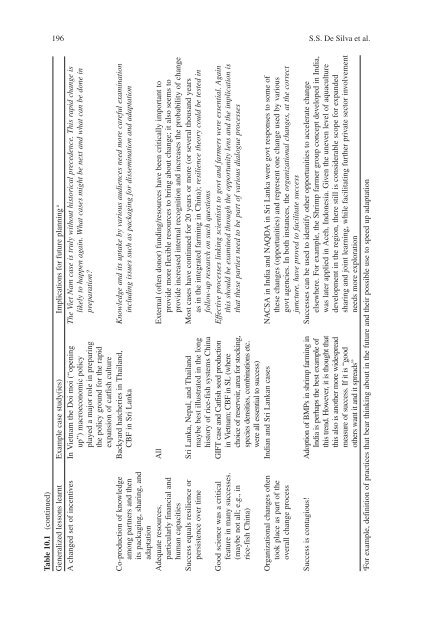Success Stories In Asian Aquaculture - Library - Network of ...
Success Stories In Asian Aquaculture - Library - Network of ...
Success Stories In Asian Aquaculture - Library - Network of ...
- No tags were found...
You also want an ePaper? Increase the reach of your titles
YUMPU automatically turns print PDFs into web optimized ePapers that Google loves.
196 S.S. De Silva et al.Table 10.1 (continued)Generalized lessons learnt Example case study(ies) Implications for future planning aA changed set <strong>of</strong> incentives <strong>In</strong> Vietnam the Doi moi (“openingup”) macroeconomic policyplayed a major role in preparingthe policy ground for the rapidexpansion <strong>of</strong> catfish cultureCo-production <strong>of</strong> knowledgeamong partners and thenits packaging, sharing, andadaptationAdequate resources,particularly financial andhuman capacities<strong>Success</strong> equals resilience orpersistence over timeGood science was a criticalfeature in many successes.(maybe not all; e.g., inrice-fish China)Organizational changes <strong>of</strong>tentook place as part <strong>of</strong> theoverall change processBackyard hatcheries in Thailand,CBF in Sri LankaThe Viet Nam case is truly without historical precedence. This rapid change islikely to happen again. What cases might be next and what can be done inpreparation?Knowledge and its uptake by various audiences need more careful examinationincluding issues such as packaging for dissemination and adaptationAll External (<strong>of</strong>ten donor) funding/resources have been critically important toprovide more flexible resources to bring about change; it also seems toprovide increased internal recognition and increases the probability <strong>of</strong> changeSri Lanka, Nepal, and Thailandmaybe best illustrated in the longhistory <strong>of</strong> rice-fish systems ChinaGIFT case and Catfish seed productionin Vietnam; CBF in SL (wherechoice <strong>of</strong> reservoir, area for stocking,species densities, combinations etc.were all essential to success)Most cases have continued for 20 years or more (or several thousand yearsas in the integrated farming in China); resilience theory could be tested infollow-up research on such questionsEffective processes linking scientists to govt and farmers were essential. Againthis should be examined through the opportunity lens and the implication isthat these parties need to be part <strong>of</strong> various dialogue processes<strong>In</strong>dian and Sri Lankan cases NACSA in <strong>In</strong>dia and NAQDA in Sri Lanka were govt responses to some <strong>of</strong>these changes (opportunities) and represent one change used by variousgovt agencies. <strong>In</strong> both instances, the organizational changes, at the correctjuncture, have proved to facilitate success<strong>Success</strong> is contagious! Adoption <strong>of</strong> BMPs in shrimp farming in<strong>In</strong>dia is perhaps the best example <strong>of</strong>this trend. However, it is thought thatthis also is another more widespreadmeasure <strong>of</strong> success. If it is “goodothers want it and it spreads”<strong>Success</strong>es can be used to identify other opportunities to accelerate changeelsewhere. For example, the Shrimp farmer group concept developed in <strong>In</strong>dia,was later applied in Aceh, <strong>In</strong>donesia. Given the uneven level <strong>of</strong> aquaculturedevelopment in the region, there still is considerable scope for expandedsharing and joint learning, while facilitating further private sector involvementneeds more explorationa For example, definition <strong>of</strong> practices that bear thinking about in the future and their possible use to speed up adaptation
















